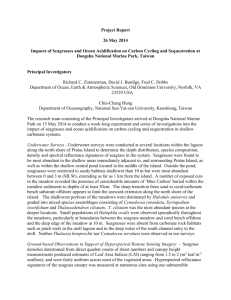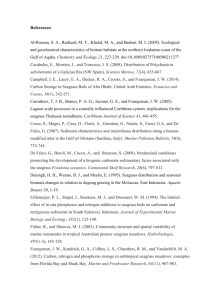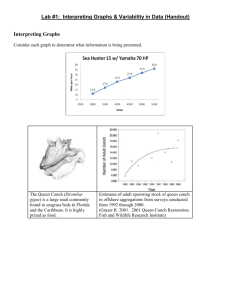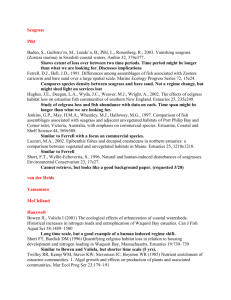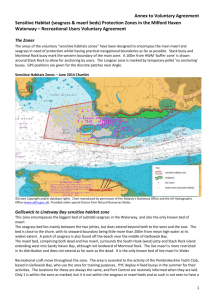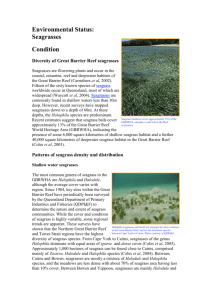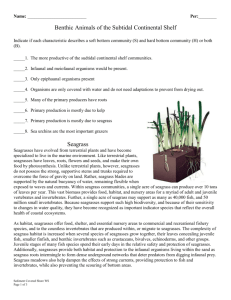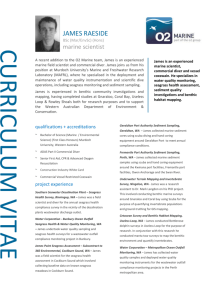Accelerating Rate and Magnitude of Global Seagrass Decline
advertisement
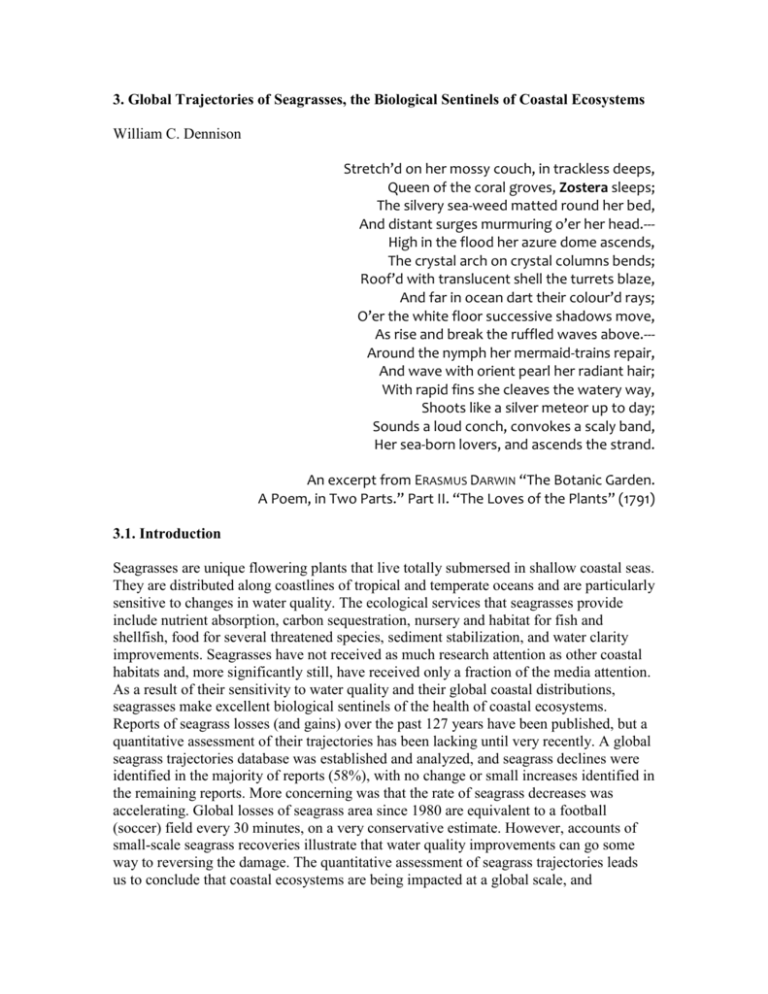
3. Global Trajectories of Seagrasses, the Biological Sentinels of Coastal Ecosystems William C. Dennison Stretch’d on her mossy couch, in trackless deeps, Queen of the coral groves, Zostera sleeps; The silvery sea-weed matted round her bed, And distant surges murmuring o’er her head.--High in the flood her azure dome ascends, The crystal arch on crystal columns bends; Roof’d with translucent shell the turrets blaze, And far in ocean dart their colour’d rays; O’er the white floor successive shadows move, As rise and break the ruffled waves above.--Around the nymph her mermaid-trains repair, And wave with orient pearl her radiant hair; With rapid fins she cleaves the watery way, Shoots like a silver meteor up to day; Sounds a loud conch, convokes a scaly band, Her sea-born lovers, and ascends the strand. An excerpt from ERASMUS DARWIN “The Botanic Garden. A Poem, in Two Parts.” Part II. “The Loves of the Plants” (1791) 3.1. Introduction Seagrasses are unique flowering plants that live totally submersed in shallow coastal seas. They are distributed along coastlines of tropical and temperate oceans and are particularly sensitive to changes in water quality. The ecological services that seagrasses provide include nutrient absorption, carbon sequestration, nursery and habitat for fish and shellfish, food for several threatened species, sediment stabilization, and water clarity improvements. Seagrasses have not received as much research attention as other coastal habitats and, more significantly still, have received only a fraction of the media attention. As a result of their sensitivity to water quality and their global coastal distributions, seagrasses make excellent biological sentinels of the health of coastal ecosystems. Reports of seagrass losses (and gains) over the past 127 years have been published, but a quantitative assessment of their trajectories has been lacking until very recently. A global seagrass trajectories database was established and analyzed, and seagrass declines were identified in the majority of reports (58%), with no change or small increases identified in the remaining reports. More concerning was that the rate of seagrass decreases was accelerating. Global losses of seagrass area since 1980 are equivalent to a football (soccer) field every 30 minutes, on a very conservative estimate. However, accounts of small-scale seagrass recoveries illustrate that water quality improvements can go some way to reversing the damage. The quantitative assessment of seagrass trajectories leads us to conclude that coastal ecosystems are being impacted at a global scale, and seagrasses are particularly at risk. To preserve seagrasses and their ecological services, there is a critical need for a targeted global conservation effort. 3.1. Seagrasses are unique Seagrasses are flowering plants that live completely submersed in shallow coastal seas. They live alongside various algae, including red, brown and green algae (“seaweed”), but are evolutionarily very different from algae. Marine algae have evolved in the ocean over billions of years and are evolutionarily very primitive, but seagrasses have evolved from land plants over the past 100 million years. Seagrasses are the only terrestrial plants to fully recolonize the sea; a surprising development considering that all plant life originated in the marine environment. It is interesting that there are no marine mosses, ferns or conifers, and only flowering plants have been able to recolonize the sea. Salt marsh plants and mangrove trees are flowering plants that also evolved from land plants, but they are restricted to the intertidal zone. There are only about 60 species of seagrasses in the world—these species live completely submersed, up to 50 or more meters deep. This stands in contrast to the 100,000 species of terrestrial flowering plants in the world. In spite of the low species diversity, these 60 seagrass species have been incredibly successful at colonizing vast stretches of coastline, forming extensive meadows and playing important ecological roles in coastal marine ecosystems. We can find analogies here to some marine mammals; whales and dolphins evolved from land animals, are few in species but are found in all oceans and have important ecological functions. The term “seagrass” does not connote that these specialized plants are a true grass. Rather it is a descriptive use, since the long strap-like leaves of most seagrass species wave in the currents like a field of grass in the wind. Also, the evolutionary analyses of the origin of seagrasses indicates multiple, separate lines of evolutionary lineage, so the term “seagrass” is not a taxonomic grouping of closely related plants, but a functional grouping of plants that look and act similarly (Hemminga and Duarte 2003). In some cases, seagrasses can look quite similar to “seaweeds”; green marine algae that may live alongside them. The various environmental factors that influence both seagrasses and seaweeds can result in similar growth forms and functions, in spite of their very different lineages. There are some freshwater flowering plants that look and act like seagrasses, and some freshwater species can actually survive in the slightly salty water found in estuaries. But the term “seagrass” is restricted to those species of flowering plants that can live totally submersed in full strength seawater. Seagrasses have colonized the shallow coastal waters throughout tropical and temperate oceans (Larkum, Orth, and Duarte 2006). They have adapted to their completely submersed life with a series of fascinating adaptations. For example, seagrasses have evolved complex pollination mechanisms involving mass spawning and the longest pollen grains in the plant kingdom. They also have internal gas canals that inflate by day and deflate by night, with internal winds to transport oxygen to their underground roots. Seagrasses have their chloroplasts in the outermost cells of the leaves, facilitating gas exchange and light acquisition. Their fiber-filled, strap-like leaves can withstand waves and currents that could destroy piers and docks. Seagrass roots exude dissolved organic matter into the surrounding sediments, which stimulates various microbes, including nitrogen-fixing bacteria. These nitrogen-fixing bacteria absorb nitrogen gas dissolved in the pore water of sediments and convert it to ammonia, which is biologically available for other organisms. Tracer studies have revealed that nitrogen gas can be converted into ammonia by bacteria, released and taken up by seagrass roots, and transported to seagrass leaves within the short span of several hours. This relationship between seagrasses and microbes in the microzones around seagrass roots is analogous to the symbiotic bacteria within the roots of terrestrial plants, for example, the legumes. This seagrass/microbe quasi-symbiosis comes into play with regard to dugong grazing. Not all seagrasses are the same with regard to their degree of root exudation and associated nitrogen fixation. It turns out that the seagrass species that are most preferred by dugong also have the most active root microbes. Moreover, the dugong-preferred species have seeds that can pass through dugong guts and remain viable. In this way, continual dugong grazing can maintain a population of seagrasses which rejuvenate their nutrients through nitrogen-fixing microbes. This intimate relationship between dugong and seagrasses has likely developed through co-evolution over millennia. 3.2. Seagrasses are widespread globally Seagrasses uniquely have both tropical and temperate distributions (Green and Short 2003). Coral reefs and mangrove forests are largely restricted to tropical regions, while salt marshes and kelp forests tend to be confined to temperate regions. Perhaps due to their multiple evolutionary lineages into the sea from multiple terrestrial progenitors, there are different assemblages of temperate and tropical seagrasses. Seagrasses have been found growing under sea ice along the Alaskan coast at temperatures of less than 0oC, as well as in shallow tropical lagoons at temperatures in excess of 40oC. Seagrasses grow along the coastlines of every continent except Antarctica. In some areas of the world, extensive shallow water habitats support extensive seagrass meadows (Short et al. 2007). The most significant of these extensive meadows in terms of area and species diversity is in southwest Australia (Carruthers et al. 2007). Not unlike what northeast Australia’s Great Barrier Reef is for corals, the southwest Australian coastline has a series of limestone reefs extending for 2,500 km, which provide habitat for vast seagrass meadows containing a third of the global seagrass species. Southwest Australia has unique oceanographic features, including a warm ocean current that flows along the coast during winter, counter to the oceanic gyre circulation pattern. This unique oceanographic feature, as well as the chain of offshore limestone reefs, makes this coastline Australia’s second Great Barrier Reef. There are various other areas that have extensive seagrass meadows, including some between the coral reefs of the Great Barrier Reef. In fact, the area of the Great Barrier Reef Marine Park covered by hard corals (6%) is less than that covered by seagrasses (13%). The ratio of reef to seagrass area is even more skewed in the Florida Bay/Florida Keys and reef tract, where the hard coral area (5%) is considerably less than the seagrass area (95%). 3.3. Seagrasses provide key ecological services Tropical seagrasses are food for several threatened species, including manatees in the Atlantic Ocean, dugong in the Indian and Pacific oceans and green sea turtles globally. These megaherbivores graze seagrass meadows repeatedly, and they have been called “cultivation grazers”. Due to historical overharvesting of these megaherbivores, the species composition and ecological role of seagrass meadows in some regions has been dramatically affected (e.g., throughout the Caribbean). Temperate seagrasses are food for waterfowl, particularly black brant geese. Sea urchins in both tropical and temperate regions feed on seagrasses, and they are part of the diets of various fish, particularly gar and pinfish. Although only a select number of animals feed on them directly, a multitude of organisms, plant and animal, depend on seagrasses as habitat for part or all of their life cycles (Heck et al., in prep.). Epiphytes that live attached to seagrass leaves or stems form a teeming microscopic ecosystem of productive plants and animals. A variety of clams, oysters, scallops and other filter feeders live on and in seagrass meadows. Various juvenile fishes use them as a protective nursery to avoid predation, while other species like seahorses live a cryptic life among their swaying leaf canopies. The way that seagrasses cope with fouling by epiphytic organisms is to constantly shed old leaves and grow new ones. A healthy seagrass shoot produces new leaves at the rate of one every 7-10 days. With shoot densities of hundreds to thousands of shoots per square meter, this means that seagrass meadows are virtually factories of what becomes detritus. The fate of this detritus is important ecologically to adjacent ecosystems. Seagrass detritus is often washed up on beaches, and it is possible to see piles of this wrack over three meters high stretching for kilometers. Human use of seagrass wrack has included housing insulation, mattress stuffing, roof thatching and automobile seat stuffing (including the original Volkswagens). Seagrass beach wrack leaches nutrients into salt marshes and coastal waters and supports amphipods and other small animals. In the ocean, meantime, seagrass detritus is decomposed by bacteria and other microorganisms. These microbes then support a detritus food web that ultimately depends on seagrass. Seagrass also gets washed into the deep sea, littering the seafloor and collecting in deep trenches where the slow-paced life can slowly decompose it. Seagrass leaf canopies baffle the water column, reducing water motion within the meadow. This reduction in water motion allows small particles to settle out, falling to the seafloor. Sediments that collect in seagrass meadows are smaller in size than in surrounding unvegetated areas. These small particles are organic-rich, thus baffling by seagrass canopies serves to increase the organic content of their sediments. Organic-rich sediments provide a substrate for bacteria, which decompose the organic material, releasing the locked-up nutrients. Seagrass roots can then absorb these nutrients to support the meadow. As a result, the leaf baffling and subsequent sedimentation in seagrass meadows makes seagrass meadows giant “filter feeders”, augmenting their diet by extracting nutrients from small particles that were in the water column. Another important ecological service that seagrasses provide is a result of sediment binding by their below-ground roots and rhizomes. The organic substances released by seagrass roots provide a sticky matrix that helps bind the sediment grains together. Leaf baffling reduces the erosive force of waves and tides that would otherwise resuspend sediments. In this way, seagrass meadows act like a ground cover that keeps the water column clear of resuspended sediments and protects the shore from some of the erosive force of waves and currents. In our current situation of greenhouse gas accumulations causing climate change, seagrasses have a particularly important role in mitigating carbon dioxide concentrations. Seagrasses evolved into their submersed existence when global carbon dioxide concentrations were higher than they are now, and their photosynthesis has been shown to be stimulated when carbon dioxide concentrations are increased. Since seagrass carbon is often not directly consumed and decomposes slowly, seagrass peat is formed in some regions and, in others, seagrass detritus is transported to the deep sea. These fates serve to effectively remove the carbon, making seagrass an important carbon sink for the planet. To put some of its ecological services into context, a soccer field of seagrass can absorb 5.8 kg of nitrogen per year (based on Posidonia meadow nitrogen uptake rates), equivalent to the treated effluent from 780 people (assuming a per capita rate of sewage production and secondary treatment). The same soccer field of seagrass can absorb 166 g. of carbon per meter2 per year, equivalent to CO2 emissions from an automobile traveling 12,000 km. The ecological services of seagrasses have been estimated at 25,000 euros per year (Costanza et al. 1997). 3.4. Seagrasses are biological sentinels Seagrasses are “coastal canaries”, a reference to their sensitivity to water quality (Fourqurean et al., in prep.). Miners used to take canaries into mineshafts, because of their lack of tolerance to degraded air quality. If the canary fainted or died, the miners knew to act swiftly and decisively and vacate the mineshaft immediately, leaving diagnosis and corrective action for a later date. Seagrasses are intolerant of water quality reductions; in fact, seagrass minimum light requirements are uniquely high among all plants. In general, seagrasses need 10-25% of ambient sunlight to simply survive and appreciably more to thrive. This high minimum light requirement makes them particularly sensitive to water clarity reductions, just as the canaries were sensitive to air quality. When sediments or nutrients from land wash into the ocean and directly or indirectly lead to light reductions, seagrasses will be the first to respond. They have proven to be good biological indicators of water quality, with the result that seagrass monitoring programs have been instituted in locations as diverse as the Mediterranean Sea, Great Barrier Reef, Chesapeake Bay and Florida Bay. Seagrasses have the ability to tap the rich nutrient resources within the soft sediments of shallow coastal seas. Their roots can absorb the dissolved nutrients, while xylem and phloem transport them internally. But nutrient-rich sediments also present a challenge to plant life, since the processes that produce these nutrients also produces a potentially toxic environment. Oxygen is consumed faster than it can diffuse from the overlying water, and toxic compounds like hydrogen sulfide accumulate. Seagrasses counter toxic compounds like sulfide by transporting oxygen from leaf photosynthesis in internal air canals (lacunae) to their roots. The additional oxygen needed for this detoxification of sediments results in seagrasses requiring higher quantities of light than other marine plants, making them particularly vulnerable to light reductions. Light reductions can occur in the water column due to dissolved substances, suspended sediments and phytoplankton. Also, epiphytes or sediment particles on seagrass leaves can further reduce the light reaching plants. Some seagrasses develop significant sugar and starch reserves to withstand temporary dips in light, but chronic light reductions through eutrophication or increased suspended sediments lead eventually to their demise. There are also other environmental factors that cause seagrass loss, among them introduced species, burial or erosion, storm damage and boat or fishing damage, but it is their sensitivity to light reductions that accounts for the most massive and persistent losses. 3.5. Seagrasses are threatened Seagrass losses have been documented for over a century. A growing body of knowledge on seagrass declines stimulated a recent quantitative global assessment (Duarte et al., in review). The magnitude of global seagrass loss rates was determined by assembling a global scientific team, devising and populating a database of published seagrass assessments and analyzing this database. Although the scientific team was familiar with seagrass dynamics and had been documenting losses in their respective regions, the fact that seagrass declines were so pervasive globally was a revelation. What they found was a global rate of decline in the seagrass area of -0.9% year-1 (median rate) and -1.5% year-1 (mean rate), using published seagrass trajectories from 216 meadows spanning 127 years. Of particular concern is that the rate of decline is accelerating, with the overall median rate (-3.7% year-1) accelerating as far as -5.5 to -8.0% year-1 since 1980 in meadows exhibiting loss of area. These published accounts of seagrass losses represent 29% of the global seagrass area since 1980. This high rate of decline and loss places seagrass meadows among the most threatened habitats on Earth, and reveals a major environmental crisis in coastal oceans. The number of seagrass meadows with increasing, no change and decreasing trajectories increases every decade, revealing the intensified sampling effort of recent years. The predominance of decreasing trajectories is evident, and the increase in all three trajectory categories is projected to continue through the rest of the current decade. The value, rate of change, has varied with time, and the largest rates, both positive and negative, occur in recent rather than older data sets. In addition to the three trajectory categories, records were kept over a decade of seagrass meadows that were either absolute gains (newly created) or losses (extinctions), with 10 out of 216 meadows qualifying. Area changes over time were particularly marked in the 1980s and 1990s, driven mainly by a large-scale decline in the northwest Florida panhandle region (United States) over the period 1984-1992. Global seagrass loss rates since 1980 are equivalent to losing a soccer field every 30 minutes, day and night, every single day. This means that in the time it takes to play a soccer match, three fields of seagrass have disappeared. A troubling aspect about this calculation is that it is extremely conservative. For example, published seagrass assessments only account for a small fraction (9%) of the mapped seagrass area. Thus, it is most likely that a soccer field of seagrass area is lost every three minutes or perhaps at even shorter intervals, since the mapped seagrass area is a fraction of its actual extent. The lack of good estimates of global seagrass area are because seagrasses are notoriously difficult to assess, confounding both remote sensing efforts and field surveys when they are in murky or deep water, remote regions of the world or growing cryptically and mixed with other features. The known global seagrass area is certainly an underestimate, with the potential area up to 35 times higher. That we have a globally significant problem is clear enough, but its actual magnitude remains elusive, and a global effort is required to assess the real seagrass area. 3.7. Seagrasses have a “charisma gap” In spite of their widespread distribution and important ecological role, the public perception of seagrasses has lagged behind that of other coastal ecosystems (Duarte et al., in review). This was recently documented in a comparison of seagrass, salt marsh, mangrove and coral scientific publication rates and media accounts. The scientific publication rates of coral reefs exceeded those of salt marshes, mangroves and seagrasses, with corals having roughly 4 times the annual rate of seagrasses. Media accounts were likewise highest in coral reefs, followed by salt marshes and mangroves, with seagrasses in the rear. Coral reefs had roughly 40 times more media reports than seagrasses. For every coral reef scientific publication, there were over 130 media reports, whereas for every seagrass scientific publication there were fewer than thirteen. This disconnect between scientific and public awareness needs to be addressed in light of the important ecological role of seagrasses and the global declines being reported. Seagrasses are not inherently “sexy” to the casual observer, lacking the colorful fish of coral reefs or the showy flowers of terrestrial plants. The animals that live within seagrass meadows are often cryptic or microscopic. Seagrass pollination is not via animals that are attracted to flowers, so colorful petals are not required. To appreciate the life within seagrass meadows, instead of swimming over the swaying leaves, divers need to settle into the canopy and wait patiently for animals to lose their fear and come slowly out to investigate. Sea horses, eels, crabs, lobsters, flounder, tiny gobies, snails, sea squirts and other creatures will begin to move about. In tropical regions, manatees or dugong will uproot entire plants like a farmer’s plow, and turtles will snip off leaves like a lawn mower, but these shy animals will generally avoid divers. In order to overcome this “charisma gap”, seagrasses need to have better press agents. Over a billion people live within 50 km of a seagrass meadow, far more than live near coral reefs or mangrove forests, yet only a miniscule fraction of these billion people even know seagrasses exist. Of course they often live in environments hostile for humans, with large waves and currents, turbid or deep water, large predators, animals that sting, bite or stab and uncomfortable water temperatures. And they are frequently found in remote or hard-to-access locations. These factors make visits to seagrass meadows difficult and serve to limit the number of people that experience them first hand. Maintaining seagrasses in an aquarium is possible, but not easy, which further reduces their familiarity to the non-diving public. Hence the “charisma gap” and the need for seagrass scientists, who invariably become conservation advocates, to provide the public with more seagrass images, videos and information. 3.6. A global seagrass conservation effort is needed While the overall situation of global seagrass declines is rather bleak, there are some encouraging case studies of seagrass recoveries that need to be studied and ultimately emulated widely. The seagrass recovery in Tampa Bay, Florida has been linked to sewage treatment upgrades. These and other case studies provide an impetus to reduce sewage effluents and other nutrient sources into coastal waters. Various seagrass restoration attempts around the world have shown us, firstly, that seagrass transplanting is labor intensive and expensive, and, secondly, that its long-term success is marginal at best. In cases where environmental degradation has led to seagrass losses, simply initiating transplanting or reseeding schemes will not work, unless the causes of the original degradation have been reversed. An important caveat regarding seagrass recovery efforts is where seagrass distributions are limited by available propagules (e.g., the Virginia coastal bays program by Bob Orth and colleagues). The important lesson from seagrass restoration efforts is that prevention of environmental degradation is a far more cost effective and successful management strategy than the restoration of degraded ecosystems. What can an individual do on behalf of seagrasses? There are, in fact, a variety of activities that will aid in seagrass conservation. Citizens monitoring programs for seagrasses and associated water quality have been set up in some areas with the involvement of non-scientists. The non-governmental organizations that support marine conservation have not, to date, embraced seagrass conservation, focusing instead on more charismatic ecosystems (e.g., tropical rain forests, coral reefs) or megafauna (e.g., whales, pandas). As shareholders in these NGOs, citizens can help direct activities toward seagrass conservation. An often overlooked aspect of any conservation activity is to actually visit a seagrass meadow. Spending time in and among seagrasses is an expression of caring and can help raise awareness. Eating seafood caught or raised in an environmentally friendly manner is another way to help, since fish pens and aquaculture ponds have been shown to have deleterious impacts on seagrasses. For coastal residents, a responsible attitude to seagrass is particularly important. Boat propeller scars can destroy seagrass beds, and responsible sailing is a prime requirement, as is taking care not to transport plants or animals from one water body to another, to avoid introductions of exotic species. Houses along the coast should have nutrient removal septic systems for the treatment of sewage. Basically, anything a coastal resident can do to minimize their impact on nutrient and sediment runoff will benefit seagrasses. The hardening of shorelines by coastal development may provide some temporary relief for coastal erosion in the face of a sea-level increase, but a hardened shoreline will prevent seagrasses from migrating inshore as the sea level rises. Climate change impacts have recently been receiving considerable global attention. Basically, recommendations to reduce the carbon footprint for greenhouse gases will have positive benefits for seagrasses. While elevated carbon dioxide levels might aid them physiologically, the overall ecological effect of climate change would be detrimental to seagrasses. Several recent cases of temperature stress have led to seagrass declines. Changes in rainfall patterns, in which extended dry periods are punctuated by intense rainfall, increase delivery of sediments and nutrients, again with a harmful effect on seagrass meadows. Marine conservation is just now embracing protected (no-take) areas analogous to refuges and parks in terrestrial ecosystems. Approximately 11% of the land surface is protected, whereas marine protected areas make up less than 1%. Most marine protected areas are generally designed for fisheries management and for habitats like coral reefs. Incorporating seagrasses into the design criteria and operation of marine protected areas is strongly to be recommended. The important ecological role of seagrasses, and the recent reports of their global decline, provide a strong impetus to develop a global seagrass conservation effort (Orth et al. 2006). If we see seagrasses as coastal canaries providing an early warning for coastal ecosystem degradation, we should follow the lead of the miners when their mineshaft canaries lost consciousness or died. They did not debate the cause(s) of the damage— they acted swiftly and decisively by first removing themselves from danger and then working to resolve the problem. And we must also react swiftly and decisively to the warning of our seagrass canaries. This action could go as far as a moratorium on coastal development, pending appropriate mitigation efforts to avoid further environmental degradation of coastal ecosystems. While there are a multitude of causes of seagrass declines, the common thread is human coastal development. What is needed then is to reduce our human footprint on the coastal zone as a matter of urgency, so future generations can enjoy seagrasses and healthy coastal ecosystems. Acknowledgements My colleagues on the Seagrass Trajectories Working Group, an initiative sponsored by the National Center for Ecological Analysis and Synthesis were essential for the development of the concepts and data expressed in this chapter. This group, comprising Ainsley Calladine, Tim Carruthers, Carlos Duarte, Jim Fourqurean, Ken Heck, Randall Hughes, Gary Kendrick, Jud Kenworthy, Suzanne Olyarnik, Bob Orth, Fred Short, Michelle Waycott, and Susan Williams also reviewed the manuscript and made helpful suggestions. This is contribution number XXXX of the University of Maryland Center for Environmental Science. References Carruthers, T. J. B., W. C. Dennison, G. A. Kendrick, M. Waycott, D. I. Walker, and M. L. Cambridge. “Seagrasses of south-west Australia: A conceptual synthesis of the world’s most diverse and extensive seagrass meadows.” Journal of Experimental Biology and Ecology 350 (2007): 21-45. Costanza, R., R. d’Arge, R. de Groot, S. Farber, M. Grasso, B. Hannon, K. Limburg, et al. “The value of the world’s ecosystem services and natural capital.” Nature 387 (1997): 253-260. Duarte, C. M., M. Waycott, T. J. B. Carruthers, R. J. Orth, W. C. Dennison, S. Olyarnik, A. Calladine, et al. “Accelerating Rate and Magnitude of Global Seagrass Decline.” Science (in prep.). Duarte, C. M., W. C. Dennison, R. J. Orth, and T. J. B. Carruthers. “The charisma of coastal ecosystems.” Estuaries and Coasts (in review). Fourqurean, J. W., T. J. B. Carruthers, W. C. Dennison, C. M. Duarte, A. R. Hughes, G. A. Kendrick, R. J. Orth et al. “More than coastal canaries: Seagrasses as early detectors and integrators of environmental condition” (in prep.). Green, E. P., and F. T. Short, eds. World Atlas of Seagrasses: Present Status and Future Conservation. Berkeley: University of California Press, 2003. Heck, K. L., Jr., T. J. B. Carruthers, C. M. Duarte, A. R. Hughes, G. A. Kendrick, R. J. Orth, and S. L. Williams. “Trophic transfers from seagrass meadows subsidize diverse marine and terrestrial consumers.” Ecosystems (in review). Hemminga, M., and C. M. Duarte. Seagrass Ecology. Cambridge: Cambridge University Press, 2000. Larkum, A. W. D., R. J. Orth, and C. M. Duarte, eds. Seagrasses: Biology, Ecology and Conservation. Dordrecht: Springer, 2006. Orth, R. J., T. J. B. Carruthers, W. C. Dennison, C. M. Duarte, J. W. Fourqurean, K. L. Heck, Jr., A. R. Hughes, et al. “A global crisis for seagrass ecosystems.” Bioscience 56 (2006): 987-996. Short, F. T., T. J. B. Carruthers, W. C. Dennison, and M. Waycott. “Global seagrass distribution and diversity.” Journal of Experimental Biology and Ecology 350 (2007): 320.

